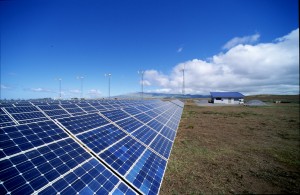The capacity of photovoltaic cells and modules in India is estimated to cross 750MW and 1250MW by the end of year 2010 as per report “Solar PV Industry 2010: Contemporary Scenario and Emerging Trends”.
The report was released by R Chidambaram, principal scientific adviser, government of India, chief guest for the function with professor Juzer Vasi, IIT Bombay and head core committee and BV Naidu, advisor, ISA. The report was supported by the office of the Principal Scientific Advisor (PSA and aims to serve as an important reference source for the various stake holders in the solar PV industry.
Solar Photovoltaic is a key technology option to realise the shift to a decarbonised energy supply and is projected to emerge as an attractive alternate electricity source in the future. The solar PV manufacturing base in India comprises primarily of cell and module manufacturing; with the bulk of the value addition taking place outside the country. The current scale of manufacturing in India is small in comparison to global standards.
The capacity in India is currently estimated in excess of about 400MW for cells and about 1,000 MW for modules. Based on the interactions with the industry, the capacity of PV cells and modules in India is estimated to cross 750MW and 1250MW by the end of year 2010. The production in India for year 2008-09 is estimated at 175MW of cells and 240MW of modules. A large proportion of the production was exported.
Solar energy is an important mitigating technology in the context of the climate change threat. The Jawaharlal Nehru National Solar Mission (JNNSM) is an important component of the National Action Plan on Climate Change.
The current report essentially captures the status of the global PV industry, status of the Indian solar PV industry including its strengths and challenges and the Indian government initiatives to promote this industry. It also includes a detailed discussion on the recently announced National Solar Mission.
Strengths and challenges of the Indian solar PV market
- Even though the industry operates at a smaller scale as compared to other solar PV producing nations, production in India is very cost effective as compared to global standards. The price competitiveness of Indian industry makes it a preferred vendor for end users in countries like Germany and Spain.
- With government initiatives in place to support and develop infrastructure for solar PV production (refer to SIPS scheme) and JNNSM to promote application of solar PV in domestic market, the Indian solar PV industry is likely to gain further edge over other solar PV producing nations.
- There is no manufacturing base in India for the basic raw material silicon wafers. The industry hence relies on international markets to source the raw material.
- The silicon market has been highly fluctuating in the past, leading to imbalance in demand supply equation, fluctuating prices and availability of raw material. Currently, the silicon production capacity is much higher than the demand and prices are at significantly low levels compared to the scenario a year back. In the past, some of the solar PV firms have entered into rate contracts with silicon wafer suppliers to ensure availability. With a sudden reduction in prices, the contracts now prove to be a loss making proposition for these firms.
- Over the last 5 years, China has emerged as the largest producer of solar cells in the world. The country currently has about 2,500MW of production capacity for solar PV as compared to India’s 400 MW. Apart from that, Taiwan, with annual capacity of 800MW, is also emerging as a major threat to the Indian industry.
- Price reduction is another major challenge for the industry as this would have greatly impact the future growth of the market.
Emerging trends
- Solar PV applications in India have followed a different trend from global practices. While globally, there has been higher focus on grid connected applications, the Indian PV market has predominately focused on off-grid applications.
- JNNSM is a welcome step from the government, to accelerate growth of the Indian PV industry. The policy addresses all the major issues currently being faced by the industry and also acknowledges key challenges in achieving the Mission objective. Grid connected solar power generation is a key thrust area of the JNNSM.
- The proposal to extend PPA duration to 25 years will improve the financial feasibility for power developers. JNNSM is technology neutral and defines a research & development roadmap to develop indigenous strengths in technology and reducing the dependence on international markets. The JNNSM also addresses issues of manpower development for the industry.
Browse related books:
![Solar PV modules in India touches 1250MW The capacity of photovoltaic cells and modules in India is estimated to cross 750MW and 1250MW by the end of year 2010 as per report “Solar PV Industry 2010: Contemporary Scenario and Emerging Trends”. The report was released by R Chidambaram, principal scientific adviser, government of India, chief guest for the function with professor Juzer […]](http://www.renewablesmart.com/wp-content/uploads/2010/05/solar-photovoltaic-india-750x500.jpg)


